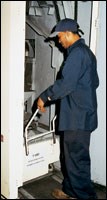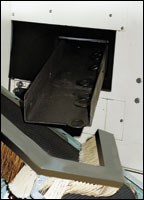Dry Deburring Improves Production
Rolex recently installed a dry deburring process to remove heat-treating scale and any burrs that may remain on parts after machining. The process produces rust-free parts, generates no wastewater and improves productivity...
Layoffs and cutbacks do not top Rolex Inc.’s (Hillside, NJ) strategy list for making it through this tough economy. Although the company is not bustling with productivity, it is gearing up for when business improves. “We have a unique way of coping with an economic turndown,” stated Neil Iden, plant engineering manager. “When production demands slow down, we shift gears and focus on productivity improvements.
The first major productivity improvement project involved the deburring system for the Belleville type precision disc springs manufactured at Rolex. Disc springs are used singly or stacked parallel or in series or in a combination. The springs are said to offer more performance and lower cost than coil springs because they are compact and long-lived, packing more loading into limited spaces. Uses range from power transmissions, valves and piping to electrical applications.
Once discs are machined or stamped from low-carbon steel, stainless steel or Inconel (nickel), they are heat treated. To remove the heat-treating scale and any rare machining burrs, parts are run through a dry roll-flow finishing machine. The system, from Finishing Associates, LLC, does not use water. The process involves the parts, media and air for cooling purposes. This eliminates any issues with wastewater treatment, which Rolex had to deal with when using its previous wet tumbling system.
Rolex has not completely abandoned the old wet tumbling system, however. It is still used for large parts that are greater than 4-inches in diameter. For example, one part made at Rolex is 10 inches around and weighs 30-40 lb. These type parts are put into tumbling or vibratory bowls. After the wet process, they have to go into a corncob mixture for drying. In addition to the extra step, there is still the environmental waste to worry about. “The new system significantly lowered the amount of wastewater we need to treat at the facility,” commented Mr. Iden. “It also eliminated the corncob drying process, because there is no water involved.”
Most importantly, this improved efficiency and, hence, productivity. Previously after heat treating, parts were sent to the tumbling department. This operation could take up to two days and was very labor intensive. “It created quite a backlog in our work flow,” noted Mr. Iden. “With the new system, parts are processed immediately following heat treatment. This has eliminated any strain on production flow.” Usual process times are 20-25 minutes, depending on part thickness, size and metal.
The unique nature of the dry deburring process requires a patented aluminum oxide media. Rolex uses three sizes of media, ranging from 6-14 mm, based on the size of the parts. The media to parts ratio is 3:1. Media consumption is approximately 0.5%/hr, and Rolex finishes roughly 500 lb/hr, meaning the company uses 1 lb of media per hour.
Rolex has three screens with different mesh sizes to separate parts and media. During part/media separation, media return to the hopper where it is then automatically reloaded into the deburring bowl. Parts exit the machine and travel up a conveyor and are deposited in a barrel.
A new load is then positioned in the machine; the door is shut and the machine started. The system lifts the load and incrementally dumps the parts into the 3.9 ft3 capacity bowl, which is already churning the media. Only the bottom of the bowl turns; the sides remain stationary. Dust from the dry disc finishing is vacuumed out through the bottom of the system. This also helps cool the process.
Following deburring, parts and media are slowly tumbled out of the bowl onto the separator screen. As explained, media pass through the screen and are collected in a hopper, while the parts pass out of the unit onto a conveyor where they are transported to a barrel. After this operation, nearly all low-carbon steel parts are phosphated, unless the customer specifically requests that they not be phosphated.
Rolex has also been able to sell some of its excess capacity on the system. “This has helped us pay for the system,” stated Mr. Iden. This is another means Rolex is using to remain productive during the slow times. “We would rather not have to lay off any of our workers. We don’t want to lose any of our skilled people,” stated Mr. Iden. “This is a time to look inward at our processes and how we can make our company more productive and efficient so that when business turns around, we are ready for it.”
Read Next
Delivering Increased Benefits to Greenhouse Films
Baystar's Borstar technology is helping customers deliver better, more reliable production methods to greenhouse agriculture.
Read MoreEpisode 45: An Interview with Chandler Mancuso, MacDermid Envio Solutions
Chandler Mancuso, technical director with MacDermid Envio discusses updating your wastewater treatment system and implementing materials recycling solutions to increase efficiencies, control costs and reduce environmental impact.
Read MoreA ‘Clean’ Agenda Offers Unique Presentations in Chicago
The 2024 Parts Cleaning Conference, co-located with the International Manufacturing Technology Show, includes presentations by several speakers who are new to the conference and topics that have not been covered in past editions of this event.
Read More














.jpg;maxWidth=300;quality=90)






